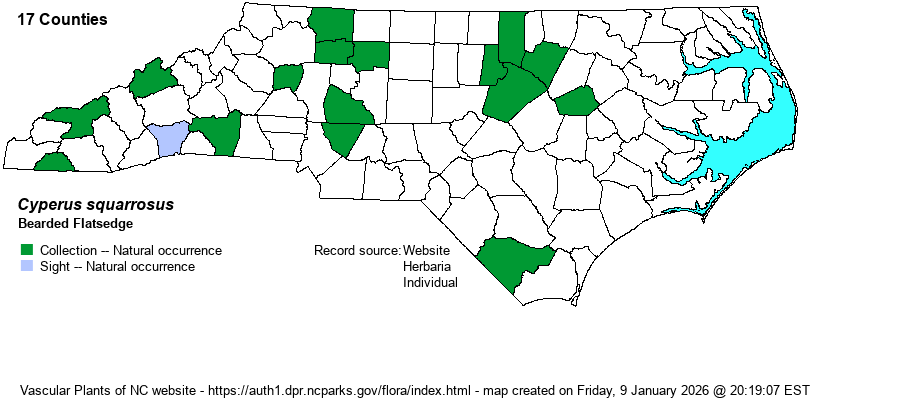| Author | L. | |
| Distribution | Widely scattered in the Mountains and Piedmont, sometimes on granitic flatrocks; a few records in the Coastal Plain. The website editors have mapped those specimens that were annotated by Tucker or other experts. The following counties are represented by specimens that are not annotated, but habitat (not granitic flatrocks) suggests C. squarrosus: Columbus, Madison, Swain, Wilson. Website editors have been conservative re accepting specimen records, due to potential confusion with C. granitophilus. Both species occur at the same (or nearby) flatrock sites in Alexander, Forsyth, Granville, Rowan, Rutherford, Wake, and Yadkin counties.
N.B. to B.C. south to FL and CA. | |
| Abundance | Rare to quite uncommon, only recorded from 17 counties. This is a Watch List species. However, it probably should be dropped as a Watch List species in upcoming years owing to now being found on lawns. | |
| Habitat | In NC, inhabits damp spots on granitic flatrocks and diabase sills, often in moss/lichen mats in full sun. Also on river shores (French Broad River in Madison County), roadsides, gravel driveway (Wilson County). In recent years, has become quite weedy in much of its Southeastern range, and is expanding in range into the Coastal Plain of the Southeast now. |
| Phenology | Flowering and fruiting May-October. | |
| Identification | Bearded Flatsedge is a very short plant (mostly 3-5 inches), with several or more stems from one base. At least one of the leafy bracts sticks up erect and far surpasses the inflorescence. It is very similar to C. granitophilus, which also grows on granitic flatrocks, but it differs in its shorter anthers (0.2-0.3 mm long vs. 0.8-1 mm) and narrower floral scales (0.5-1 mm wide vs. 1-2 mm wide). As both of these are rather rare in the state, correct ID is critical. | |
| Taxonomic Comments | Synonyms include C. aristatus and C. inflexus.
The genus Cyperus is mostly tropical and warm-temperate in distribution; thus, in NC it is much commoner in the Coastal Plain than in the Mountains and Piedmont. Most species have 1-few flowering stems (culms) from grasslike basal leaves, plus a few stem leaves. At the summit is an inflorescence of very open and branched, or tightly packed, spikes, varying among species from brown to golden brown to straw-color to reddish. The arrangement of the spikelets is important, whether like a hand (digitate) or in paired or alternate rows (pinnate); as is the shape of the achene (seed), whether bi-convex in cross-section or triangular. As a group, Cyperus tends to be weedy and readily enters disturbed ground; this is true for many natives as well as all the aliens. In recent years, following DNA research, the genus has incorporated several genera that in RAB (1968) or other manuals were separate: Hemicarpha, Lipocarpha, and Kyllinga. | |
| Other Common Name(s) | Awned Flatsedge | |
| State Rank | S2 | |
| Global Rank | G5 | |
| State Status | W7 | |
| US Status | | |
| USACE-agcp | OBL link |
| USACE-emp | FACW link |

